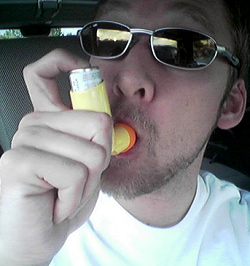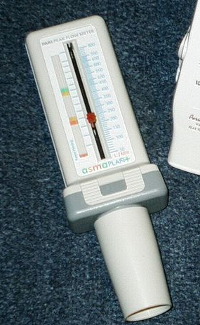(advertisement)

Asthma inhalers can provide instant treatment when symptoms arise.
Asthma is a disorder that affects the respiratory system, which may cause a chronic respiratory impairment in some people or a sporadic illness manifested by periodic symptoms resulted from a number of triggering factors.
What Causes Asthma?
Asthma can be caused by environmental and/or genetic factors. It may be triggered by external stimulants, such as antigens, a substance that causes the immune system, in sensitive individuals, to overreact and respond by producing an overload of antibodies.
Allergic individuals can be over sensitive to tobacco smoke, air pollutants (such as smoke or fumes), cold or warm air, perfume, pet dander, dust (including dust mite excrements) or moist air. Asthma symptoms can also be caused by emotional stress, colds, flu, respiratory infection, exercise, exertion or some other allergies.
Exercise can induce asthma too, and not only in people who are known asthma sufferers. While exercise-induced asthma will affect most people with asthma, it also affects around 1 in 5 people who do not have asthma. Elite athletes are more likely to suffer, with around 50% of pro-cyclists suffering an asthma attack at some point during their careers.
(advertisement)
Asthma Symptoms
An asthma attack irritates the airways causing it to contract, become swollen and in some cases produce excessive amount of mucus. The onset of an asthma attach may be sudden. As the airways carry air in and out of the lungs, their constriction and inflammation make it difficult to breathe, giving a sense of tightness in the chest.
The common symptoms of an Asthma episode are: dydpnea (shortness of breath), stridor (a high-pitched, noisy respiration), coughing, wheezing (mainly during expiration, but can be in both respiratory phases), prolonged expiration, rapid heart rate, tightness and itching of the chest, feeling breathless and inability for physical exertion.
Within a rigorous asthma attack, the sufferer can turn blue due to the lack of oxygen, and may suffer from chest pain or even loss of consciousness. Some cases of asthma with no wheeze or stridor, can be misdiagnosed for COPD (chronic obstructive pulmonary disease), due to severe shortness of breath and tightening of the lungs.
Preventing Asthma Attacks
Asthma re-occurrence can intervene with daily life, therefore, preventing an asthma attack can help the sufferer to carry on with their life as normal as possible. In order to receive treatment for asthma you need to see your doctor, who can prescribe medication such as preventers and relievers, which are taken through an inhaler.
The relievers are used when the asthma attack is taking place. It works by relaxing the muscles of the airway, allowing the person to breath more easily. So, the relievers help to alleviate the symptoms, but cannot help to prevent them.
The preventers are used to minimise the risk of having an asthma attach by reducing the amount of inflammation in the airways. It should be used every day, as instructed by the doctor or nurse, with or with out having the symptoms of an asthma attack in order to keep the inflammation of the airways under control. As they may be inflamed and producing mucus even if the symptoms are not present at the time.
(advertisement)
If inhalers are not keeping the asthma under control, the patient may be prescribed steroid tablets to settle down the wheezing and breathlessness.
Apart from taking regular medication (see below for available medications), individuals suffering from asthma can help themselves by following preventive guidelines such as:
- Not smoking, as it irritates the lungs and airways, worsening the condition.
- Stop Aspirin – Aspirin can be a trigger, so switching aspirin for an alternative drug is advisable.
- Avoid contact with triggers – e.g. fur or feathers, domestic animals, like cats and dogs, can also be a trigger factor for some people.
- Reduce house dust mites, as they can trigger allergy. Use a special cover for the mattresses and pillows to prevent breathing in house dust mites. Use sprays to kill the mites.
- Clean the carpets regularly and consider replacing the ones in the bedrooms for vinyl or wood flooring, as carpets tend to accumulate dust mites.
- Use an ioniser or air purifier in the bedroom to help clear the air and minimise possible trigger factors.
- Take regular gentle exercise. Improving your cardiovascular fitness can help to manage asthma. Do not use asthma as an excuse to not exercise.
Developing night time cough or being awaken often during the night, can mean that the asthma is not under control and should be checked by a doctor.
In case of a person developing wheezing at any time or think they may have asthma, or their symptoms are not under control, they should see a doctor to receive the correct treatment.
Asthma Medications
As asthma research has advanced over the years more medications have become available. New medications have fewer side-effects and some can help control asthma symptoms in patients who are suffering from more severe forms of asthma. Remember, you should never start a new type of medication without guidance from a fully qualified doctor.
There is still no cure of asthma, medication can only treat the condition by helping to improve lung function to reduce attacks, and also to reduce symptoms during an attack. Asthma is still the most common chronic respiratory condition in both children and adults, and this has certainly prompted a lot of investment into asthma research.
Every Patient is Different
Treating asthma is not straightforward, as each person will require a course of medication to suit their own specific requirements. Often trial and error is used to determine the best level of medication. This may sound haphazard, but doctors are able to make very good educated guesses concerning the type and amount of medication that a person needs.
There are essentially two types of medication: drugs to help prevent an asthma attack, and drugs which help to control and stop an asthma attack. Unfortunately asthma often follows a seasonal pattern, meaning that at certain times of the year it can be much worse, for example during spring when there is more pollen in the air.
Common Asthma Treatments
Bronchodilators
Bronchodilators help to relax and widen the muscles of the airways to allow more air to flow. The drug is taken using an inhaler and the effect is almost instant, making them the best option if an asthma attack starts.
Long Acting Inhaled Bronchodilators
These provide a similar action to standard bronchodilators, but are usually used by more severely asthmatic people who often take them at night to ensure that the airwaves stay clear. These medications are often used alongside inhaled corticosteroids.
Inhaled Corticosteroids
Unlike bronchodilators, corticosteroids are designed to provide a constant level of protection from an asthma attack. They work by reducing inflammation and swelling in the airways, which can greatly reduce the chances of a sudden onset of asthmatic conditions. Also, when asthma attacks do occur they can be more serious if there is chronic swelling.
Leukotriene Modifiers
This drug can either be used on its own to treat mild asthma attacks, or used with inhaled corticosteroids in more severe cases.
Theophylline
This drug is used to relax the muscles in the respiratory tract. It is the hardest drug to manage as dosages must be very carefully measured and symptoms and side-effects monitored to ensure there are no complications following administration of the drug. Possible problems include difficulty breathing, increased heart rate, irregular heart beat or seizures. Should any of these symptoms appear a patient must contact a doctor immediately.
There are other medications, however, what we have listed above make up a large percentage of all medical treatments for asthma.
Alternative Medical Treatments
Although there are several products marketing to “naturally treat” asthma, there is currently no scientific evidence that any natural, holistic or alternative therapy helps to prevent asthma, and certainly no treatments which will help a person suffering from an asthma attack.
Managing Asthma

A Peak Flow Meter to Monitor Volume of Airflow
If you suffer from asthma it is vital to take steps to manage it as effectively as you can. This means following the rules on reducing the triggers, taking medication and improving your lifestyle to make yourself a fitter and healthier person.
Monitoring of your lung health is an effective way to help manage the condition. Regular use of a peak flow meter will allow you to identify when lung capacity has fallen, before symptoms can be felt or an attack starts. If a peak flow meter starts to record lower than average readings then it is time to take some additional medication, such as inhaled corticosteroids, to widen the airways and maintain steady airflow.
Asthma is a terrible condition and it can become chronic, meaning that a person will suffer it all their life. While health science still has found no cure or cause, research is indicating that pollution during foetal development and early childhood plays a role.
Further Reading and References
- Asthma UK – Charity which provides support, information and advice for asthma sufferers
- Asthma – NHS Choices – UK Government website information
- Guideline 101: British Guideline on the Management of Asthma
- What is asthma? : Canadian Lung Association
- Asthma: MedlinePlus
Photo credits: Man in car with asthma inhaler, by Nathan T. Baker.
(advertisement)

